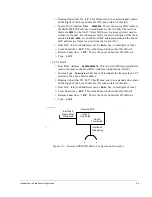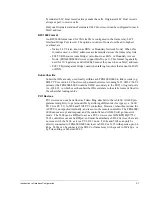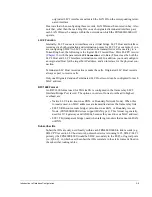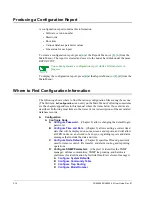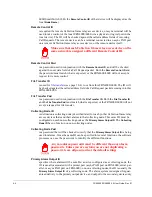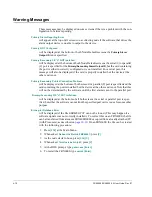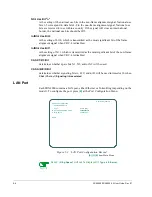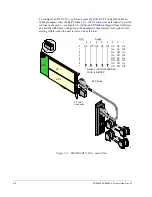
4-4
FRX4000/FRX6000 4.0 User Guide, Rev 01
6000/SmartSwitch 1840, the
Remote Control ID
of that device will be displayed as the
local
Node Name
.)
Remote Control ID
is required if a remote Cabletron frame relay access device, or async terminal will be
used to take control of the local FRX4000/6000 (via a physical or logical port in the
local device). The ID will be checked against the called address fields of incoming
Call Requests. The remote device can be a terminal connected to an async PAD port
on a remote Cabletron frame relay access device, or the remote device itself.
Make sure that each Cabletron frame relay access device on the
same network is assigned a different Remote Control ID.
Remote Control Pwd
is a password used in conjunction with the
Remote Control ID
, and will be checked
against the user data field of a Call Request packet. Both the
Remote Control ID
and
the password must match what is expected, or the FRX4000/6000 will not accept a
request for remote control.
File Transfer ID
is used for
file transfers
(see page 18-4) to or from this FRX4000/6000. The ID will
be checked against the called address field of a Call Request packets coming into this
FRX4000/6000.
File Transfer Pwd
is a password used in conjunction with the
File Transfer ID
. Both the
File Transfer ID
and the
File Transfer Pwd
must match what is expected, or the FRX4000/6000 will not
accept a request for file transfer.
Collecting Node ID
is defined on a collecting node (described later) for use by other Cabletron frame relay
access devices that send their alarms to that collecting node. This same ID must be
configured on each non-collecting node as the
Primary Alarm Output ID
. The
Collecting
Node ID
has no function on non-collecting nodes.
Collecting Node Pwd
is a password that will be checked to verify that the
Primary Alarm Output ID
is being
used for alarms. Since the same ID can be specified for several functions, the software
processes can use the passwords to identify the different functions.
Any non-alarm passwords must be different than any alarm
passwords. Unless you are certain you are not duplicating a
password, leave all passwords at the default settings.
Primary Alarm Output ID
specifies where alarms will be sent. On a device configured as a collecting node, the
ID is usually associated with a printer port (async PAD port on FRX4000; serial, par-
allel, or async PAD port on FRX6000); on non-collecting nodes, the ID is usually the
Primary Alarm Output ID
of a collecting node. The alarm system is designed for guar-
anteed delivery to the primary output device, and output to the secondary device only
Summary of Contents for Netlink FRX4000
Page 2: ......
Page 16: ...xiv FRX4000 FRX6000 4 0 User Guide Rev 01 ...
Page 17: ...Section I Getting Started ...
Page 18: ......
Page 24: ......
Page 37: ...Section II Configuration ...
Page 38: ......
Page 52: ......
Page 78: ......
Page 106: ...7 24 FRX4000 FRX6000 4 0 User Guide Rev 01 ...
Page 142: ...8 36 FRX4000 FRX6000 4 0 User Guide Rev 01 ...
Page 186: ......
Page 216: ......
Page 266: ......
Page 273: ...Section III Operation ...
Page 274: ......
Page 296: ......
Page 324: ......
Page 376: ......
Page 377: ...Section IV Appendices ...
Page 378: ......
Page 384: ......
Page 390: ......
Page 396: ......
Page 400: ......
Page 405: ...Menu Structure E 5 ...
Page 406: ...E 6 FRX4000 FRX6000 4 0 User Guide Rev 01 ...
Page 425: ......
Page 426: ......


